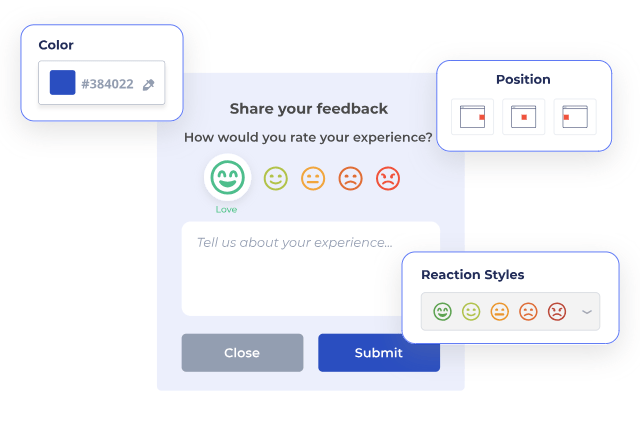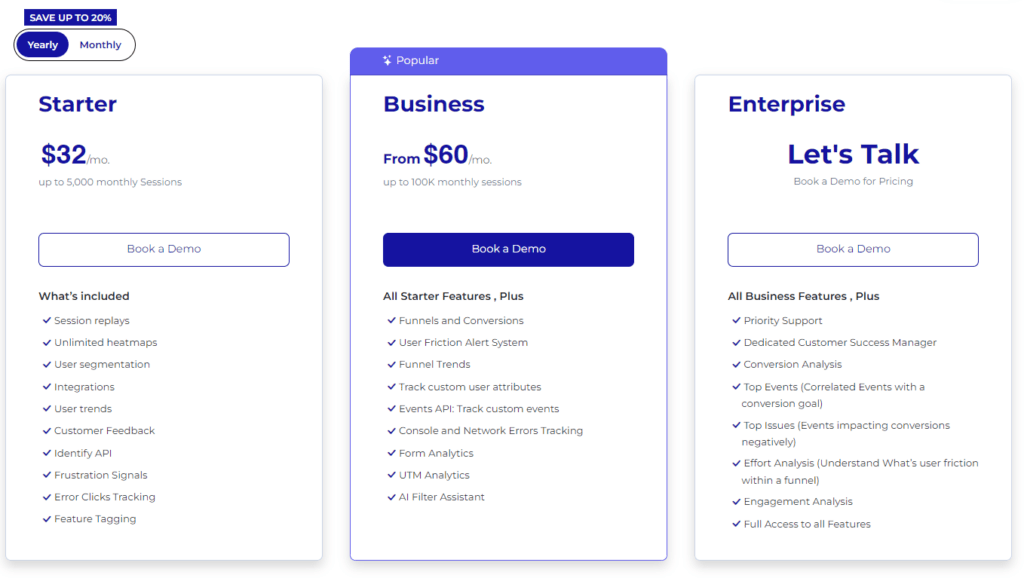Are you looking to optimize your website's performance but unsure if VWO is the right choice? You're in luck! We've compiled...

How To Ask Open Ended Questions? (5 Examples)
When you get feedback from customers, the goal is to get real insights, not just yes or no answers. Open ended questions are your ticket there. They're like keys that unlock what's really on your customer’s mind, giving you the full picture. Think of them as conversation starters; they invite people to share their thoughts in detail.
Read on to learn what open-ended questions look like, compare them with close-ended questions, and see some valuable examples which can help collect quality feedback from your customers.
What Are Open Ended Questions?
Open-ended questions are questions that allow the reader to answer in any way they like, rather than just a yes or no. They are a useful way for companies to gather detailed feedback from their clients or employees.
The format is commonly used in customer feedback surveys, as it provides much deeper insights than the standard Yes-No questions. Open-ended questions often begin with words like "how," "why," "what," or "describe," so they can invite respondents to explain, elaborate, or explore a topic in detail.
Differences Between Open-Ended Questions and Closed-Ended Questions
While closed-ended questions require readers to choose a single-word answer, often 'yes', 'no', and sometimes - 'maybe', open-ended questions allow readers to answer in their own words and share their opinions.
Here are some examples of open-ended questions:
- What do you like about our product?
- How was your onboarding experience?
- Which are your favorite features from our product and why?
Let's see some closed-ended questions, too:
- Do you like our product?
- Was your onboarding experience enjoyable?
- Do you like our dashboard feature?
When you are gathering product feedback, the main benefit of open-ended questions is letting readers express their experiences however they want it, rather than how you frame the question.
How to Write Open-Ended Questions?

Open-ended questions should start with words that can lead readers into giving detailed answers, instead of short ones. And here, we're going to show you how to write an open-ended question in a couple simple steps:
- Focus on asking questions that start with 'How,' 'Why,' or 'What'.
- Avoid questions that lead to a particular answer.
- Encourage readers to provide a descriptive response rather than a one-word answer.
- Ask follow-up questions to allow readers to explain the answer in more detail.
4 Tips for Effective Open-Ended Questions
You might be wondering how to compose your survey questions so you get the the best possible answers. And it's understandable. Let's see three useful tips that can help you get a detailed response.
1. Your Question Should Be Easy-To-Answer
Your questions should always be clear and concise. It should be straightforward enough that respondents don't feel confused. But make sure it's also broad enough to allow for a spectrum of responses; you're looking for context here, not just black-and-white facts.
2. Don’t Lead the Question
Avoid leading the reader. Phrasing matters a lot because even the slightest suggestion can steer an answer off course. You need to encourage respondents to express their opinions openly, so you can gather valuable feedback and enhance your product.
3. Don’t Make Assumptions When You Have Answers
The best way might be through curiosity without presumption. It's tempting to assume we know what our customers think but it may not be accurate. Instead ask something genuinely curious about their experience without any hint of assumption baked in.
4. Encourage Readers to Write Free-Form Answers
Provide just enough detail to guide readers but leave room for personal interpretation. Instead of asking them if they like the product, you can ask them to describe their own experience.
Open-Ended Question Examples
If you've ever been on the receiving end of a "How was your day?" that led to an unexpected heart-to-heart, then you know the power of an open-ended question. In customer feedback and surveys, these types of questions are like gold mines for digging into what your customers truly think and feel about their experience with your product or service.
Question 1: Can you describe how our product made a difference in your daily routine?
This question is designed to let customers share their stories. It's not just asking if they liked the product; it's probing deeper—how did it integrate into their life? You might find surprising ways people use your products or meaningful impacts that never crossed your radar.
Question 2: What challenges were you hoping to address by using our service?
Aiming straight at the 'why' behind a purchase can give insights beyond surface-level satisfaction metrics. The query opens up conversations around expectations versus reality, which can be critical when fine-tuning offerings or developing new features.
Question 3: If you could change one thing about our platform, what would it be and why?
We're not fishing for compliments here—we want constructive criticism. Encouraging frankness may seem scary but trust us—it is where growth happens. Users will often provide actionable suggestions that can drive innovation within FullSession's website and product feedback software.
Question 4: How do you see yourself continuing to use our app in the future?
This forward-looking inquiry doesn't just ask users if they'll stick around—it gets them envisioning long-term engagement with your brand. Plus, understanding ongoing user needs helps anticipate market trends so we stay ahead rather than play catch-up.
Question 5: How easy or difficult was it to learn to use our product? Can you elaborate on your learning experience?
Such a question can be pretty helpful to gather useful insights from your target audience. You need to ask questions which promote critical thinking, so you can get as much information as possible from survey respondents.
What Is the Role of Open-Ended Questions in Collecting Customer Feedback?
Compared to close-ended questions, open-ended questions encourage respondents to elaborate on certain topics which can help you get interesting answers and opinions on your product from a customer's perspective.
Think about it: when you ask someone "How was your day?" you get much more than if you'd asked "Was your day good?" Open-ended questions in surveys work the same way. They give us detail—the 'whys' behind the 'whats.'
How to Gather Rich Feedback Through FullSession?
To gather rich feedback effectively using FullSession's website, businesses should create open-ended questions that allow them to gain deeper knowledge of what customers truly think. It can also boost your customer experience analysis by a mile.
With features designed specifically for capturing comprehensive user sentiment, FullSession provides both flexibility and depth in survey design and lets companies not only hear but understand every chuckle, sigh, rant—or rave.
How to Use Open Ended Questions for Feedback?
Gathering authentic, insightful customer feedback can be as much of an art as it is a science. Open-ended questions are the paintbrush that helps you color outside the lines of yes-or-no data, revealing the nuanced opinions and experiences of your users. With FullSession's website and product feedback tools, tapping into this wealth of qualitative information becomes simpler.
1. Set Up Your Feedback Framework
To start, ensure your survey or feedback form includes sections where customers can express their thoughts freely.
Create prompts that feel like a conversation rather than an interrogation. Think: 'Tell us what you love about our checkout process' instead of 'Do you like our checkout process?'. It’s these little tweaks in phrasing with FullSession's customizable forms that let customers know you’re genuinely interested in their input.
2. Capture In-Depth Insights
When using FullSession, capture not only what readers type but also observe how they interact with your site through session recordings before and after providing feedback. These behavioral breadcrumbs lead to richer insights – why did several users mention difficulty finding information even though navigation seems intuitive?
This dual-lens approach enables deeper understanding by correlating user actions with their articulated concerns or praises, giving context to otherwise isolated comments.
3. Analyze Responses Effectively
Once responses flood in through FullSession surveys filled with well-crafted open-ended queries, sorting them might seem daunting—but fear not. Categorize responses based on themes such as usability issues or feature requests which help identify common threads across diverse user inputs.
Leverage built-in analytics tools to sift through qualitative data efficiently—no manual labor required here—and get ready for some eye-opening patterns that could redefine how you perceive user satisfaction (or lack thereof).
4. Incorporate Feedback Into Strategy Development
You've got the quantitive data needed for success. Now it's time to put it to work. Use these insights from open-ended question analysis via FullSession reports to inform business strategies and development priorities directly linked back to real-user needs because nothing beats making decisions based on direct-from-the-source intel.
Install Your First Website Feedback Form Right Now
It takes less than 5 minutes to set up your first website or app feedback form, with FullSession, and it's completely free!
FullSession Pricing Plans

Here are more details on each plan.
- The Starter plan costs $39/month or $32/year and allows you to monitor up to 5,000 monthly sessions with up to 6 months of data storage.
- The Business plan costs $75/month or $60/year and helps you to track and analyze up to 100,000 monthly sessions with up to 12 months of data storage.
- The Enterprise plan has custom pricing and offers customizable sessions plus full access to all features.
Conclusion
Open-ended questions are a valuable tool for companies to gather detailed feedback from their clients or employees. Unlike yes or no questions, they allow individuals to respond in any way they choose, providing more comprehensive and insightful information.
You can use these questions to open conversations that reveal valuable feedback which your cannot access if your provide a limited number of answers (which is the territory of closed-ended questions.)
FullSession's tools can help collect and analyze customer responses effectively and make sure nothing slips through the cracks.
FAQs In Relation to Open-Ended Questions
Are multiple choice questions open-ended questions?
No, they are not. Multiple-choice questions are leading questions, because they provide pre-generated answers.
What are two characteristics of open-ended questions?
Open-ended questions start with 'how', 'what', and 'why'. They also allow businesses to build rapport with their consumers, as the latter will feel understood and appreciated.
Is it good to use open-ended questions?
Yes, open-ended questions can provide companies with much broader insights from their customers. Many Fortune 500 companies are using them as a way to uncover hidden problems or find areas for improvement.
What is an example of an open-ended question statement?
Good open-ended questions examples include questions like, "Describe how you use the app in your daily routine." and provoke a deeper thought, rather than one-word answers.




